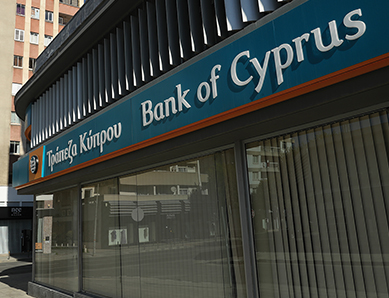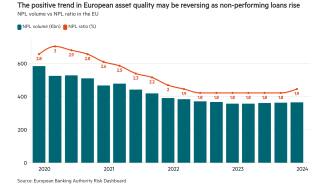It is rare for a country’s bankers to talk proudly of how they have slashed the sector’s assets-to-gross domestic product (GDP) ratio and cut the value of deposits by 30%, but in Cyprus they are doing just that. Seven years after a banking crisis that led to an unprecedented bail-in, the eurozone’s first capital controls and a €10bn rescue package from international partners, the Cypriot banking sector has undergone a remarkable turnaround.
Cleaner, leaner and better capitalised, Cypriot banks are less reliant on foreign depositors and less exposed on the asset side. But the country still faces challenges with a substantial non-performing loan (NPL) burden that is now unlikely to shift in the near future. The global coronavirus crisis will take its toll and, combined with the growing cost of investments in technology, this may lead to a further round of consolidation.
From boom to bust
The liberalisation of Cyprus’s previously heavily regulated financial sector in the 2000s, together with the boosts provided by EU accession in 2004 and eurozone membership in 2007, led to the rapid expansion of the banking industry. Banks sucked in deposits from foreign citizens, particularly from Russia and the Commonwealth of Independent States (CIS), who were attracted by high interest rates, low taxes and light regulation.
By 2010, banking assets were more than eight times GDP, and the following year 55% of all deposits were from non-residents, according to the Association of Cyprus Banks. Cypriot banks in turn invested heavily in both sovereign and corporate Greek bonds, at a time when many other investors were reducing their exposure to Greece after the global economic crisis. Banks on the island were also over-exposed to the previously booming local property sector, which saw values drop significantly following the global recession.
The crunch came with the Greek financial crisis. In 2011, Athens agreed a deal with international creditors that saw sovereign bond holders take a 50% haircut. Cyprus’s two largest banks, Bank of Cyprus (BoC) and Laiki (or Popular) Bank, saw combined losses of €3.5bn on the Greek haircut alone – equivalent to 10% of Cyprus’s GDP. As Frank Gill of Standard & Poor’s said at the time: “It is important to understand that the Cypriot banking crisis was born on the asset, not the liability, side of the balance sheet.”
For a period, the Central Bank of Cyprus responded by using emergency liquidity assistance approved by the European Central Bank (ECB) – broadly speaking, emergency loans against collateral that the ECB will not itself accept. But with Cyprus’s external financing position rapidly worsening, this was not sustainable.
Saviours and successes
In 2013, the situation came to a head in tense meetings of eurozone finance ministers in which Cyprus’s president threatened to pull out of the single currency. The conclusion, after several months, was a €10bn emergency package from the ‘Troika’, comprised of the International Monetary Fund, the ECB, and the European Commission, which imposed stringent conditions. Depositors in BoC and Laika saw savings of more than €100,000 subject to a haircut in an unprecedented ‘bail-in’ to save the system.
The government imposed capital controls to prevent a run on banks, which were only removed in 2015. Laika was shuttered and folded into BoC, and the banking sector was overhauled. The government, meanwhile, pursued austerity measures under the aegis of the deal as it looked to return to international capital markets.
By most measures, the programme proved a success. Cyprus exited the Troika agreement in March 2016 as planned, having only used €7.5bn of the original loan extended. “It is important to contextualise – the banking crisis in Cyprus was unlike any other in the EU,” says Cleopatra Kitti, a Cyprus-based international consultant and non-executive director. “Shareholders, Cypriot businesses, households and individuals were bailed in. Deposits were wiped out but not debt.”
One aim of the 2013 measures was to downsize the banking sector considerably, which has been successful. In 2010, banking assets were equivalent to 811% of GDP, and by 2018 this had been reduced to 286% – below the EU average. Overall banking deposits have fallen from €69bn in 2011 to €49bn as of September 2019, and the proportion belonging to non-residents has dropped from 45% to 31%. The system loan-to-deposit ratio dropped from 107% to 70% between December 2014 and September 2019.
“The banking sector is in much better shape: higher capital, lower NPLs and consolidation of the sector,” says Alex Boulougouris, co-head of research at investment bank Wood & Company.
Return to liquidity
Fiona Mullen, director of Nicosia-based consultancy Sapienta Economics, says: “The most impressive turnaround was in liquidity. BoC inherited more than €9bn in emergency liquidity assistance from Laiki, on top of the €2bn it had itself. Many thought it could not survive that, and yet it has paid it all off and is now flush with deposits, which means it has also regained trust.”
BoC remains the country’s largest bank, and has performed solidly in recent years. In the first three quarters of 2019, it reported new lending of €1.6bn while retaining a loan-to-deposit ratio of 66%, and posted profit after tax of €116m – following a loss of €104m in 2018. Following the sale of €2.7bn of NPLs in June 2019, the bank has reduced NPLs by 73% since 2014, and built up its coverage to 51%.
Hellenic Bank, which ranks second in terms of assets, reported approved lending of €537m in the first nine months of 2019, and posted profit after tax of €89.4m for the period. Hellenic acquired the operations of Cyprus Co-operative Bank in 2018, boosting its share of system deposits from 12% to 30.9% and loans from 8.6% to 19.5%.
Cypriot bankers assert that they have accepted the necessity of downsizing, despite the cost, and that lower growth is a price worth paying for a more sustainable market. They also emphasise a change in culture in the sector, towards considerably tougher compliance. “Cypriot banks are recapitalised, with a diversified shareholder profile, governed by boards operating under strict EU oversight and good governance principles,” says Ms Kitti.
Tighter regulations
Regulations have been tightened on the identification of ultimate beneficial owners and on shell companies, and the systemic de-risking has led to a reduction in exposure to jurisdictions including the CIS. Banks have also stopped accepting clients from ‘high-risk’ sectors such as crypto-currency dealers, online casinos and adult entertainment companies.
While domestic customers complain that stringent anti-money laundering (AML) rules raise costs and slow processes, a February 2020 report by Moneyval suggested there is still some way to go. Following a comprehensive review of the country’s processes for AML/countering the financing of terrorism, it urged the authorities “to pursue more aggressively money laundering from criminal proceeds generated outside of Cyprus, and take a more proactive approach to the freezing and confiscation of foreign proceeds”.
The Association of Cyprus Banks’ recent focus has been on implementing the EU’s Fifth Money Laundering Directive, and rehabilitating Cyprus’s banking reputation internationally. Now it has another urgent challenge: to address the fallout from the Covid-19 pandemic.
The government is pushing some of its economic support measures through the banking system, with €1.75bn to guarantee new low-interest loans to businesses and the self-employed, and €250m to subsidise part of the interest paid by loan holders. The guarantees will see the government cover up to 70% of any loss arising from the loans, with the credit institution covering the remaining 30%, whether the credit is secured or unsecured.
Few observers doubt that the sector is in better shape than it was on the eve of the 2013 crisis. Deposits total €48.4bn and gross loans €33.6bn as of January 2020, giving excess liquidity equivalent to 66% of GDP, according to Sapienta Economics. BoC has €3.4bn and Hellenic Bank €7.4bn of this.
“The two main banks are both highly liquid and well capitalised,” says Ms Mullen. “Actions by the eurozone authorities to loosen capital requirements will also help them weather a short-term storm.”
NPL challenge
Those factors should help the main banks manage the impact of the government’s March 29 decision to suspend capital and interest payments on many loans. Sapienta estimates that this could affect loans totalling €25bn (the government suggests €16bn), with banks foregoing up to €881m in interest income, which accounts for 77% of bank revenues.
A longer term concern is that the crisis will add to NPLs at a time when Cyprus’s disposal programme was making progress after years of political hold-ups. The NPL ratio stood at 28.6% as of September 2019, according to the central bank, down considerably from the 2014 peak, but still one of the highest in Europe.
“Two unknowns are whether this latest crisis has changed the face of tourism for ever – which will affect NPLs – and whether the loan suspensions will push borrowers more generally back into a non-payment culture that had taken a long time to unwind,” says Ms Mullen. “NPL disposal is going to be more difficult in the short term, and maybe the medium term, so the banks might find that the only way out is to be acquired by bigger foreign banks that have the balance sheets to withstand them.”












